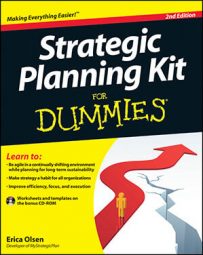The process of strategic planning achieves the outcome of aligning each employee with the organization’s mission. Gallup conducted a study of more than 80,000 managers in 400 companies to determine the most successful managerial behaviors. From that study, they drilled in on 12 key focus areas or traits that best correlate with business success, including the following:
Aligning each employee with the mission
Letting employees know what’s expected
Tapping in to the talents of employees
Talking with employees about their progress
You don’t need to predict the future but do plan for it and lay a roadway to get there. An organization that plans thoroughly has overall succession planning built in as part of its planning process, or as an outcome of the process. Although this study reinforces common sense, remember that everyone wants to be able to make a difference and have an impact every day.
To keep a good employee base, consider the following:
Help the people in your organization understand how their day-to-day work impacts the larger mission of the company through a variety of ways, from engaging different groups in the planning process to linking performance to the broader mission.
Provide your employees with the support they need, such as timely communication and the best tools and work environment, to do their jobs. Doing so goes a long way.
Be sure to link your employee training programs to your overall strategy. Then everyone can be part of the process of helping the company succeed.
Find the right skill sets for the job. We all know that a square peg never fits into a round hole.
Appreciate your staff and, by all means, challenge them. Then be sure to fairly reward them, and they’ll be more likely to stick around. Rewards are often monetary, but they can also be non-monetary, such as providing teams more autonomy or freedom to work differently.
As you’re going through your strategic management process, remember these ways to be proactive in order to navigate through all the competition and achieve sustainability.
Don’t forget to think about the longer-term future of your staff, too. According to FranklinCovey’s “The Greatness Challenge” campaign, by 2018, 60 percent of experienced U.S. leaders will leave the workforce. Because of this, succession planning is often one of the top strategic initiatives in organizations today.
Although positional succession planning is also important, corporate succession planning comes in the forms of a plan and a planning process that transfers tribal knowledge and decision making to the next level of leaders.
Bundled in that idea is the importance most all employees put on wanting to advance to the next level and gain more authority and responsibility. So strategic planning not only sets the corporate direction but also functions as real-time succession planning throughout the organization.

